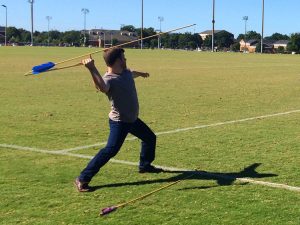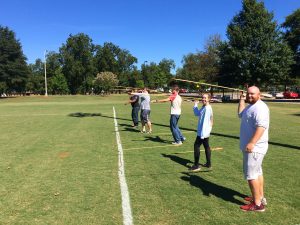by Juan Ponce-Vázquez, Department of History
As someone who teaches courses on colonial Latin American history in Alabama, and previously in the rural northeast, I have not had many chances to bring history to life for my students. In the past, I have taken students to museums when a temporary exhibit came to a nearby city. For the most part, however, teaching within my discipline involves the classic things you have come to expect from a history class: lectures, active student participation in discussions, papers, and readings.
From time to time, I have also been able to introduce a few period films that do not fall into the well-known clichés of depicting Spaniards as Catholic zealots (Pirates of the Caribbean: On Stranger Tides), unredeemable villains (any film on Queen Elizabeth I), or sympathetic drunkards tormented by a six-fingered man and fantasies of revenge (I am looking at you, Íñigo Montoya!).
I am always on the lookout for activities that might alter the pace of the semester and create an opportunity for students to experience some of the class contents in a more distended and relaxed atmosphere. The buzzword here is “experiential learning.” We have heard it often, and you might have dismissed it as another fad in academia, but this is something we have been doing all along.
In my case, I always try to get students to place themselves in the shoes of the people they are studying. Even more difficult is to get them to envision the lives and struggles of individuals whom they may have never identified with prior to taking my class.
While teaching at St. Lawrence University, my colleagues at the anthropology department did something they called an “atlatl battle.” Don’t worry, it was not a real battle but a marksmanship competition in which students used atlatls, a Native American spear-thrower commonly used in Mesoamerica and the Mississippi region before the arrival of Europeans. Students had a great time, and this gave me the idea to incorporate something similar in my course.
Once in Alabama, my colleague Steve Bunker encouraged me to find a way to make it part of Colonial Latin America survey (HY 111). The History department was extremely supportive, and with their help, I acquired five atlatls and ten six-foot spears. Equipped with such an arsenal, and once I got the clearance from campus security personnel (phew!), I had to find a point in the semester in which I could tie atlatls in with the class themes to maximize the students’ experience. That moment was the early 16th century and the Spanish conquest.
When talking about the Spanish conquest, my goal is always to dismount the common assumption that Spanish success was due to superior weaponry and tactics. Disease, the social, political, and cultural context of the societies the Spanish encountered, and lots and lots of Native American allies were the real protagonists of the conquest.
Still, students continue to identify with the conquistadors. This year, when referring to the Spanish, a student referred to them as “we,” a slip of tongue that confirmed my suspicion: when studying the confrontations between Europeans and Native Americans, students will often identify with the Europeans, even if these Europeans are those pesky Spaniards.
I hope the atlatls somehow helped to bring to life Nahua warriors as they faced the men of Hernán Cortés and his thousands of Indian allies.
I met with my students on the campus recreation fields, and after discussing war as a cultural encounter in which Spanish and Nahua warriors brought with them very different meanings, I taught students to use the atlatls, and we played a few different games of marksmanship. It was a beautiful October day, and I think students enjoyed the experience. Hopefully, for a brief moment, they identified with those Nahua warriors, at a time in which their world changed forever.
I am still trying to come up with new activities for my atlatl day. If you have any ideas, please do not hesitate to share them with me. This activity taught me two important lessons: first, anthropology is fantastic (OK, I already knew that!), and second, we can learn so much from our colleagues in other disciplines. The cross-disciplinary possibilities for collaboration and learning are endless. Keep your eyes open, and don’t take them for granted. You never know what you can bring to your own terrain.

